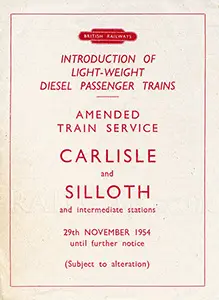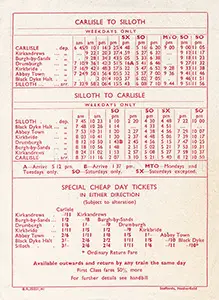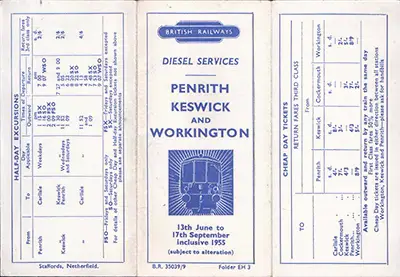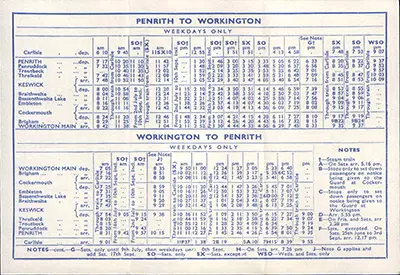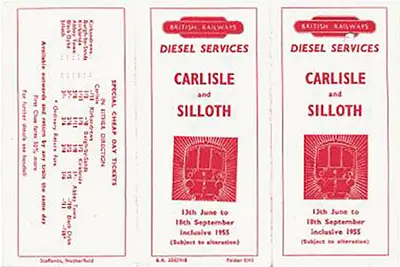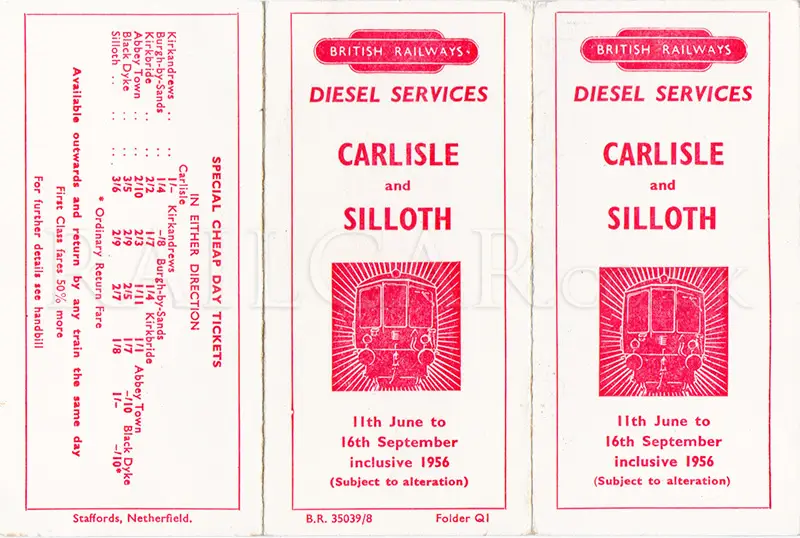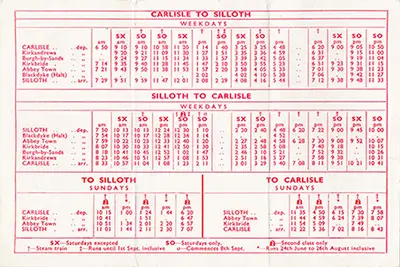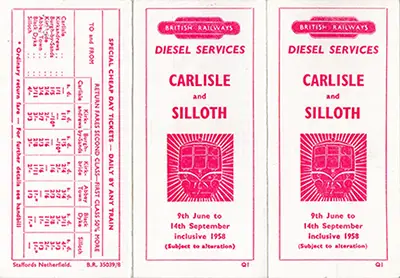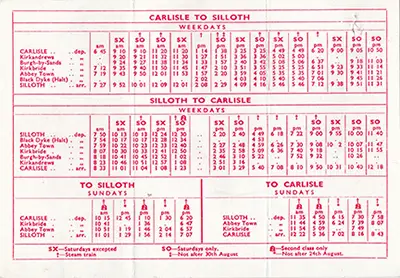Derby Lightweight (Yellow Diamond) 1, 2 & 4-car DMUs
West Cumberland Operations
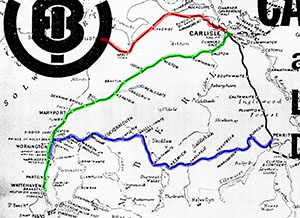
Thirteen power trailer sets were built specifically for the West Cumberland area (nowadays known as Cumbria) to operate on three lines: Carlisle to Silloth (red on map); the Carlisle - Maryport - Workington - Whitehaven line (green); and the Workington, Cockermouth, Keswick & Penrith line (blue). All would be delivered to Calisle Upperby depot, some would move to Workington. They would be joined by more sets moved from other LMR schemes. By the time of their replacement by Class 108s in 1969 around 75% of all LMR Derby Lightweight (79xxx series) power cars would have spent time allocated to Carlisle, some of the original routes had closed and their use would spread to other routes from the city.
1954
Tests
The first set - 79008/79600 - was noted undergoing trials on the Wirksworth branch hauling a BTK on the 21st October 1954. The first recorded appearance in the West Cumberland area was on the 10th November 1954 when the same set ran trials to Whitehaven & Silloth. This was the first of many trials M79008 made in Cumbria and in the Manchester Area with M79600 either as a MC + DT set, hauling BCK coach M7308, or with M79010 as a power twin. Measurements and recordings were made of rail speeds, accelerations, engine speeds, oil and water temperatures.4
Stage One: Carlisle to Silloth
DMU services in the area were introduced in stages, the first on 29th November 1954 was the Carlisle to Silloth service (red route on map). There were little alterations to timings.
Sets 79015/79607 and 79016/79608 travelled north from Derby works to Carlisle on the 17th December 1954, while the next set 79017/79609 was tested on the Wirksworth branch on the 20th December. The 35mph speed limit on the branch was eased to 50mph for the trial.
The passenger figures/receipts for the first four weeks of traffic can be found here.
Driver Training
Initially West Cumberland drivers were sent to Derby for a weeks training, including learning some of their mechanical features.
When the railcars first became available for driver training at the end of 1954 a dual link for both diesel and steam driving was formed from existing staff at Carlisle. This arrangement continued satisfactorily, aiding flexibility of staff-working while both types of motive power were used over the same routes. At Workington there was a separate diesel link formed by senior steam drivers.
The mobile diesel instruction train visited from time to time, and some maintenance staff were sent to courses at AEC in Southall, and Self Changing Gears in Coventry.
1955

Stage Two: Workington, Cockermouth, Keswick and Penrith
The second stage began on the 3rd January 1955 when they were introduced to the Workington to Penrith service through the north end of the Lake District (blue route on map). The pattern of the service remained basically the same, with six trains daily each way, but there were considerably accelerated timings over steam workings. The 46½ miles from Penrith to Workington was achieved in 80-86 minutes, as opposed to the previous 97-121 minutes. While there were no additional services, they were more evenly spaced, and all but one had the previous lengthy wait at Keswick eliminated. The 7.05am and 12.22pm from Workington worked through Penrith to Carlisle, and the 9.40am from Carlisle worked through as the 10:20am from Penrith to Workington, giving Keswick a much wanted through service to Carlisle. The image is a British Railways publicity shot of a Penrith bound set arriving into Bassenthwaite Lake on July 7, 1955.
Skipton
On 26 January 1955 a set did a trial run from Skipton to Carlisle in 1 hour and 45 minutes. This image shows the set at Skipton.
Press Tour
On the 1st February 1955 a special train formed of a 2-car set took the Mayors of Whitehaven and Workington, chairmen of urban district councils in West Cumberland, press and BBC representatives over two of the lines being or soon to be DMU operated. They were invited and hosted by A. Higginson, District Commercial Manager of LMR at Barrow. The train left Keswick at 1.53pm, and travelled over the main line to Carlisle, then to Workington and Whitehaven before returning to Keswick at 5.09pm.
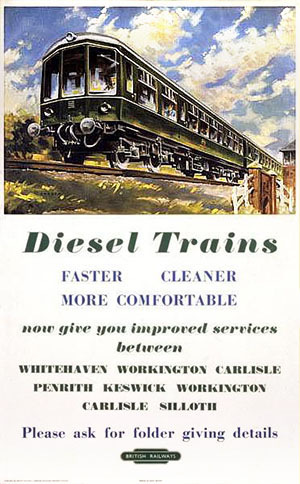
Stage Three: Carlisle - Maryport - Workington - Whitehaven
The final stage was the Carlisle - Whitehaven service to which they were introduced on the 7th February 1955 (green route on map). Steam timings from Carlisle had been at 5.40am, 6.50am, 8.25am, 11.07am, 1.25pm, 4.20pm, 5.06pm, 6.15pm, 7.50pm and 9.05pm. These were replaced by an even interval service at 25 minutes past the hour from 8.25am till 4.25pm, and then at 5.15pm, 6.15pm, 7.50pm, 8.30pm and 9.25pm. The 5.40am and 6.50am departures remained as before, most likely to fit in with factory starting times etc. Saturdays had additional trains at 1.00pm and 9.10pm, and the 1.25pm was replaced by a 1.50pm departure.
This increased the services from ten to sixteen, and from twelve to eighteen on Saturdays. The services stopped at Dalston, Wigton, Aspatria, Bullgill, Maryport, Flimby, Workington, Harrington and Parton. Timings for the 27¾ miles to Maryport was 42 minutes (previously 47-50 minutes), the 33¼ miles to Workington in 54 minutes (previously 62-65 minutes), and the 40 miles to Whitehaven in 74 minutes (previously 86-92 minutes). All the services kept these timings except the 5.40am, 6.50am and 9.25pm which were given extra time for handling parcels, although most of this work was done by two steam hauled parcels trains.
From Whitehaven services were hourly from 6.55am to 2.55pm and then at 4.15pm, 5.15pm, 6.15pm, 6.45pm, 7.55pm and 9.55pm. Journey times were the same in this direction. The turnaround times at both ends was 16 minutes, allowing a set to do up to five return journeys a day, a total of 400 miles.
Overall, the timings were little improved over previous steam schedules, particularly as the steam schedules had been decelerated in the year or two prior. The 7.55am from Whitehaven managed to knock 15 minutes of the schedule of the previous 7.48am steam train, although it only knocked 13 mins of the previous summer's schedule. The 5.15pm from Whitehaven now took one minute longer, and three minutes longer than the previous summer's. In the up direction accelerations ranged up to 15 minutes, although the 5.40am from Carlisle took only the minute less, and the 7.50am two minutes.
It was mentioned that standing times at stations seemed to be excessive, and that the schedules could be cut once experience had been gained in operating the sets. The diesels made it necessary to introduce a service of steam-hauled parcels trains between Carlisle and Whitehaven, and the two trains were run daily in each direction comprised mainly of LNER six-wheeled parcels vans.
The Sunday service was a vast improvement, with nine services instead of the original two at 6.45am and 4.00pm from Carlisle and 11.00am and 6.30pm return. The DMU times were well spaced out, and as Dalston, Bullgill, Flimby, Harrington and Parton were all closed on a Sunday, the journey only took 66-67 minutes.
This third stage was thought to have particularly good prospects, as the stations at Carlisle, Maryport, Workington, Whitehaven and Aspatria were all fairly centrally situated in the towns, allowing them to compete better with road transport.
Success
Once the services were underway they were well patronised.
By 19th February 1955, despite only starting with eight of the thirteen sets required for the full service, there had been 8,000 additional passengers carried in West Cumberland, and by April takings were up 40%.
Between the start of the Carlisle and Whitehaven service in February 1955 and the end of April 1955, 91,600 passengers were carried compared to 59,000 in the corresponding period in 1954. The Cockermouth, Keswick & Penrith line saw an increase of 8,300 to 18,500, and between Carlisle and Silloth had an increase from 24,400 to 28,900.
The success of the services meant that there were increased demands on the sets, with maintenance time reduced and two of the three spare sets used in traffic. The matter was discussed at the April Lightweight Trains Committee meeting with the descision made to seek further sets particularly with the upcoming summer season. The minutes of the next meeting were the first to contain a breakdown of the vehicles allocated to schemes, and this sheet dated 16 June 1955, showed that two power cars and a trailer car had been allocated to the scheme for delivery in February 1955.
Summer 1955 Changes
The Summer 1955 timetable provided for three additional trains from Penrith to Workington and two in the opposite direction compared to Summer 1954, and also an additional Carlisle - Keswick service on Wednesdays & Saturdays.
A staff strike in June 1955 saw a 2-car unit working an early afternoon turn between Workington and Penrith, and return.
The 'Leyland Journal' of July 1955 stated that the passenger increases were at the expense of road passenger traffic. Although there was a slight fall in road traffic, there had been a considerable increase in travel by public transport as a whole. It gives the examples of a sales rep. who found the new services more convenient than travelling by his car, and it claimed that most of the traffic is made up of former car-users, or is completely new.
First Transfers
During the period four weeks ending 16/07/55 six sets, 79015-20 and trailers, were transferred from Upperby to Workington; the depot now had an extra building added specifically for servicing diesels.
Cumberland Lakeland Cruises
The LMR saw that it could make further use of the good all round visibility that these sets offered. They first advertised two Sunday excursions, on the 29th June and 19th July 1955, running from Morecambe via Barrow and the West Cumberland coast to Keswick, returning via Shap and Oxenholme. This route gave passengers an excellent view of the coast and scenery beyond Keswick and Shap.
The trains, named the 'John Peel Land Cruise', departed Morecambe Euston Road at 10.00am, then ran non-stop to Keswick arriving at 12.47pm. Departure was at 3.00pm, arriving back at 4.45pm. The fare for the round trip was 12/6d, and tickets limited to 123 (the number of seats), although extra sets, to a maximum total of three would be added if there was sufficient patronage. Holders of holiday 'Runabout' tickets in the area (no. 3) could join the train for a 2s 6d supplementary fare. It was to be extended to other dates if successful.
However the June 1955 staff strike meant that for the first run the passengers had to be taken around by bus instead. Regardless, this and the second trip were an outstanding success and a further eight Sunday trips were added that summer, some called the 'Queen of the Lake Excursion' and over 3,000 passengers took advantage. There were also excursions to Morecambe, including on the 18th September, 2nd and 16th of October from Carlisle for the Illuminations.

The image shows three sets on the West Coast Main Line, passing over the Dillicar water troughs in the Lune Gorge just south of Tebay. Date unknown, each set is carrying sideboards so it is probably an excursion.
West Cumberland Collision
In one the first accidents concerning a first generation DMU, a car plunged through a fence by a railway cutting near Keswick on 21st August 1955, falling 30ft on to a path beside the line. It came to rest with part of the vehicle on the track, and was hit by a pair of 2-car sets running empty to Cockermouth to work a half day excursion to Morecambe. The car driver was seriously injured, but his wife only slightly. No member of the train crew were injured, but the train had to be taken out of service. Excursion passengers were taken by bus from Cockermouth to Keswick, where they joined a relief train.
Mileage
The mileage for each of the power cars on October 1st 1955 was noted as:
- 79008 54,955
- 79009 52,551
- 79010 48,201
- 79011 52,162
- 79012 48,316
- 79013 52,938
- 79014 51,010
- 79015 46,120
- 79016 50,260
- 79017 42,930
- 79018 45,278
- 79019 30,113
- 79020 45,404
At the time 79010 was in Derby Works for wheel turning as the vehicle had been having trouble with the brake gear causing abnormal tyre wear, it was expected other vehicles wouldn't require tyre turning until after 60,000 miles.1
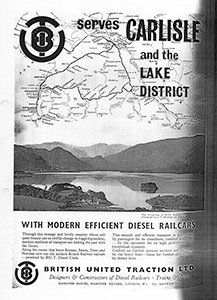
Continued Success
By October 1955 traffic was well up, in some cases as much as 80%. After 12 months there were 529,302 tickets sold, compared with 340,610 the previous year. Full details of the 1955 passenger receipts can be found in the minutes of the Lightweight Trains Committee (LWTC): to January 22nd; to February 19th; to April 9th; to June 4th; to September 10th; to October 31st; to November 30th; to December 31st.
More vehicles
The LWTC October meeting agreed that three two-car sets being built for the Birmingham Part 1 scheme could be temporarily loaned to West Cumberland so that units in service could receive scheduled Works attention. This resulted in 79118-20 (and 79639-41) being delivered to Carlisle Upperby at the end of the year on-loan from Monument Lane. By this time the Works maintenance was underway, the thirteen sets were expected to be treated at the rate of one per week and completed by February 1956. The area was still expected to receive an additional permanent allocation of two power cars and a trailer car, delivery of these was now expected in March 1956.
The 'new' dates of the Birmingham sets were:
26/11/55 79118 new to Upperby on loan from 3E (returned ex-loan January 1957)
10/12/55 79119 new to Upperby on loan from 3E (returned ex-loan February 1957)
10/12/55 79120 new to Upperby on loan from 3E (returned ex-loan October 1957)
1956
By February 1956 the drivers on the diesel link suggested that another 10 minutes could be cut from the current 1 hour 14 minute schedule for the run from Carlisle to Whitehaven. At the time most of the sets working the C.K.& P. line ran to and from Workington, the forthcoming timetable change would see then instead operated to and from Whitehaven. This would end changes and irritating delays at Workington.
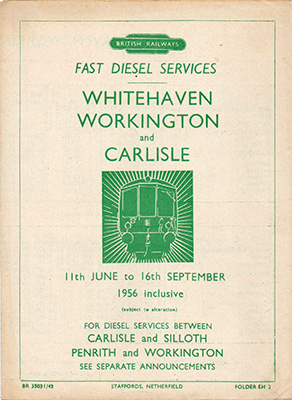
The return of the vehicles on loan from Birmingham was delayed, the February LWTC meeting noted that this was now unlikely before the end of March. Authority from the British Transport Commission for the extra two power cars and one trailer was given by the same meeting, at which point the LWTC decided another trailer car should be sought to give them fifteen permanent sets. This was confirmed at the following meeting, but the allocation of units at that meeting noted that the two power cars and one of the trailer cars (now expected to be delivered in April 1956) that were allocated would first go on loan to Birmingham, the extra trailer car (no supply date given) would come from the Manchester Part One scheme.
By the end of April 1956 the scheduled Works attention due to have completed by the end of February was still ongoing.
This year the LMR planned 18 half day Sunday Land Cruise excursions through the Lake District with the sets, as well as many other summer trips. Tours started from Barrow, Workington, Maryport, Carlisle, Morecambe and Baventhwaite Lake on various Sundays between May and September.
The Stephenson Locomotive Society organised a West Cumberland Diesel Rail Tour on Saturday 11th August 1956. The circular tour covered all the West Cumberland service, including the Silloth branch, by advertised services. The group departed Carlisle Citadel on the 12.55pm service and arrived back at 7.04pm, the fare for the journey was 14/6.
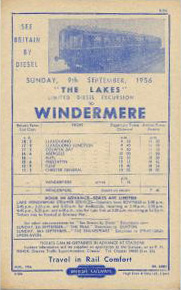
Passenger Figures / Receipts
These can be found for 1956 in the minutes of the Lightweight Passenger Trains Committee: to February 29th, to March 31st, April, June, September, October, November, December.
1957
Petrol Rationing
In January two West Cumberland sets (M79020/612 and M79118/639) were transferred to Birmingham so the rush hour services on the Lichfield (City) - Four Oaks - Birmingham (New St.) line could be strengthened and augmented to handle the increased number of passengers during petrol rationing, the latter set returning to Monument Lane ex-loan. The reduced number of sets in West Cumberland resulted in a number of the DMUs on the Silloth branch being replaced with steam trains from the 21st January 1957, and on Saturdays all trains were steam operated except the 6.50am from Carlisle and 7.50am from Silloth. The official reason given to the public for the withdrawal of certain of these trains was the oil shortage.
79020/79612 would return to Workington in February, when 79119/79640 were returned to Monument Lane from their loan to Upperby. From June to October 79118/79639 were back at Upperby, no doubt for increased loading in the summer season. The third of the sets loaned from Birmingham (79120/79641) would be returned to Monument Lane in October, all three of these sets would return to West Cumberland for good in 1958.
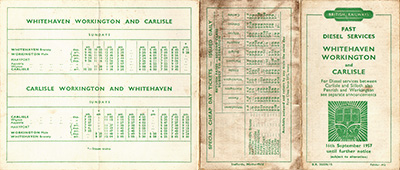
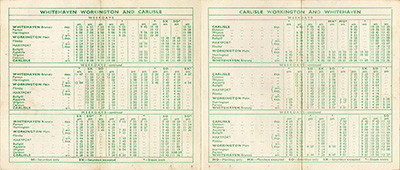
Power Twins
When 79118/79639 and 79120/79641 departed in October their place was taken by two power twin sets from Llandudno Jct.

A six-car (three two-cars) formation in Workington station on September 12th, 1956. Stuart Mackay Collection.
The 1957 allocation changes were:
79020 Jan-57 On loan Workington to 3E (Monument Lane)
" Feb-57 ex-loan back to 12C (Workington).
79118 Jan-57 ex-loan Upperby to 3E
" Jun-57 3E to Upperby
" Oct-57 Upperby to 3E
79119 Feb-57 ex-loan Upperby to 3E
79120 Oct-57 ex-loan Upperby to 3E
79184/185/189/190 Oct-57 Llandudno Jct to Upperby
For the allocation changes on this page a matching trailer car would normally accompany a power car, but the numbers were not given in LMR stock changes.
Passenger figures for 1957 continued to rise, with 144,585 passengers carried in West Cumberland in one month compared with 140,710 in the same month of the previous year, an increase of 3,875. More details can be found in the minutes of the Lightweight Passenger Trains Committee: January, February, March, April, May, June, July, August, September, October, November, December.
1958
In January one power-twin (79185/190) went on loan to 24E (Blackpool Central), arriving on the 17th, along with two sets from Llandudno. While there it would be transferred away from Upperby and would not return. For the summer season 79118-20 would return from 3E, the latter two as a permanent move, the first initially on loan. In September departures were power-twin 79184/189 on loan to 26A (Newton Heath), they would be transferred away from Upperby before returning but 79184 would return in later years. The move of 79118 to Upperby was made permanently in December, a month that also saw 79124/125 arrive from Watford.
The 1958 allocation changes were:
79118 Jul-58 on loan to Upperby from 3E
" Dec-58 to Upperby from 3E (previously on loan)
79119 Jun-58 3E to Upperby
79120 Jun-58 3E to Upperby
79124 Dec-58 Watford to Upperby
79125 Dec-58 Watford to Upperby
79184/189 Sep-58 on loan Upperby to Newton Heath, later transferred to Speke Jct
79185/190 Jan-58 on loan Upperby to Blackpool, later transferred to Speke Jct
In West Cumberland driving staff worked an average of eight hours each day. A typical working day began by reporting for duty at 10.53am at Workington, taking a two-car diesel set on the M.&C. section to Carlisle and a return run through to Whitehaven. This was followed by a short run from Whitehaven to Workington after which there was a compulsory break of 35 min. The driver's working day was completed taking another two-car set from Workington to Penrith via Keswick on the CK&P. section and returning to Workington, signing off at 6.53 p.m. having drived about 160 miles.
Passenger figures for 1958 from the minutes of the Lightweight Passenger Trains Committee: January, February, March, April, May, June, July, August, September, October, November, December.
1959
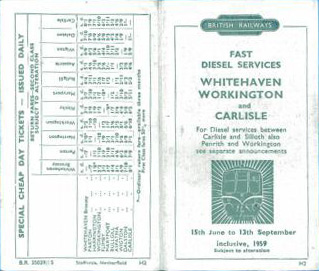
In January 79010 moved from Upperby to Speke Junction; in October to Reddish; and would not return to Carlisle until 1965. In May 79125 departed Upperby for Llandudno Jct.
At the end of March 79017/607 returned from shops as the first set in the area to carry the lighter shade of green and with the coaching crest.
A typical 1959 summer diagram (no. 352) involved a Carlisle set starting with the 5.45am to Whitehaven coupled to the Cravens parcel car, which it remained with for the return journey. On its own the power/trailer then made another three trips to Whitehaven before returning around 6.20pm. The 8.25am weekday service to Whitehaven was operated by a 6-car set, and 4-cars were use on other services during the day.
The Cockermouth, Keswick & Penrith section had some steep gradients. Typical vehicle acceleration obtainable through the gears when climbing a ruling gradient of about 1 in 300 enabled 15mph to be reached from rest in 10sec, 25mph in 30 sec, 30mph in 50 sec, 45mph in 2min 30 sec, 50mph in 3min 10sec and 55mph in 4 min 10 sec. On the long climb up the 1 in 63 east from Threlkeld 33mph could be reached and maintained in 3rd gear when carrying around 30 passengers. These figures were taken from a power car which engines had completed 15,800 miles and 27,800 since overhaul, the vehicle was still 88,620 miles from shopping, and was considered to be below average in general performance.
1959 Passenger figures from the minutes of the Lightweight Passenger Trains Committee: January, February, March, April, May, June, July, August, September, October, November, December.
1960
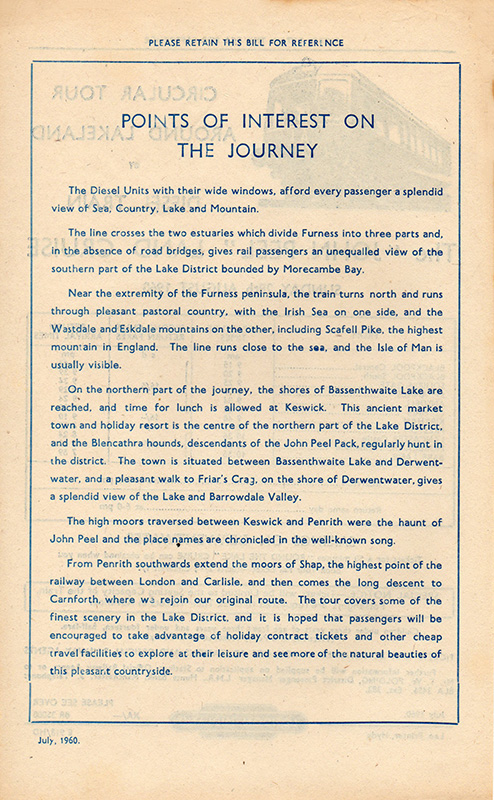
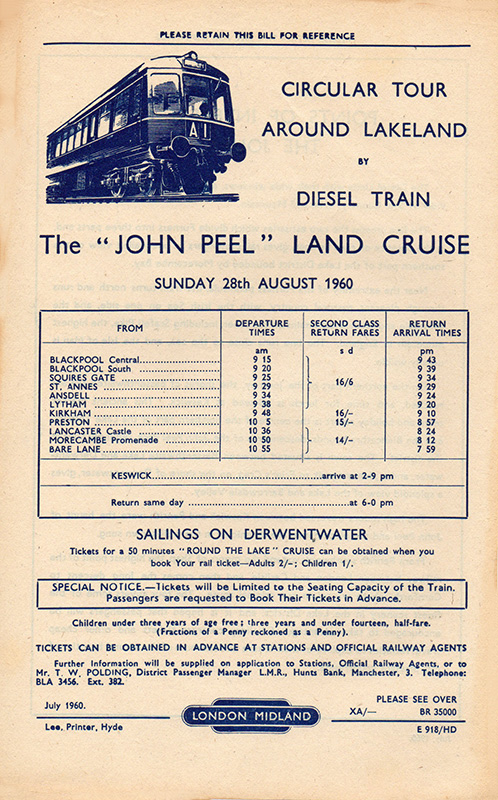
In January 79124 was transferred from Upperby to Reddish. The West Cumberland fleet now consisted of twelve of the original sets, three additional power/trailers (79118-20) and the Cravens parcels unit 55997. In a normal weekday eleven two-car trains were required for traffic, leaving four sets available for maintenance. Twelve sets were required on Saturdays.
The original sets were always easily identifyable by the red seats (with green trim) in second class.
By 1960 there were additional through trains from Carlisle to Workington via Penrith. Passengers had to detrain at Penrith while the set was shunted over to the Keswick line, which did not please them. However, following a complaint about this practice from a passenger after having to get out into the wind and rain while travelling on the 5.05pm appearing in a railway magazine, this was soon changed, allowing passengers to remain on board.
On September 10th the Railway Enthusiasts' Club ran a railtour using a two-car set which included running inside goods sheds in the Carlisle area. The power car was M79009.
Tail Loads
It was known for up to three four-wheel vans to be hauled by the sets but this was discontinued by 1960 as a maximum of 15 tons trailing load was imposed. This still allowed for the occasional attachment of one fish van. If the Cravens parcels van was attached the trailing load allowed was 25 tons, allowing a 24-ton six-wheel parcels van to be occasionally taken on the main line from Penrith to Carlisle.
Passenger figures from the minutes of the Lightweight Passenger Trains Committee: January, February, March (this was the last set of figures they published for the area).
1961 - 1963

Three years with no allocation changes.
The image shows a LMR poster promoting diesel trains. Although not specific to the West Cumberland services - "among the lovely holiday areas served by London Midland diesel trains are English Lakeland and North Wales, where reasonably priced Day Trips and Runabout Tickets (in the season) help you to get around and about" it depicts Bassenthwaite Lake between Keswick and Cockermouth.
The oil painting used on the poster was painted by the artist Barber in 1961. There are more details on the National Railway Museum website about the poster and the original painting now in their care, and other posters done by the artist.
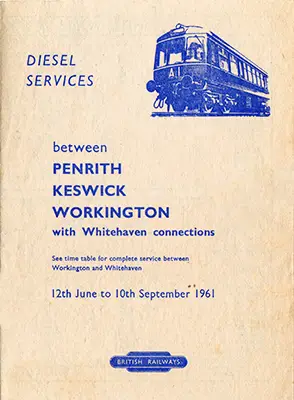
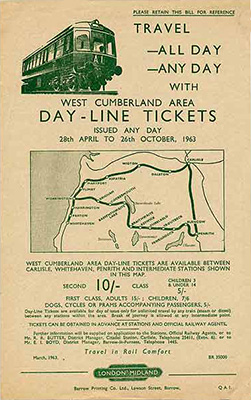
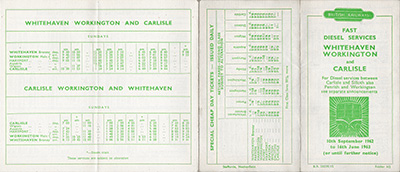
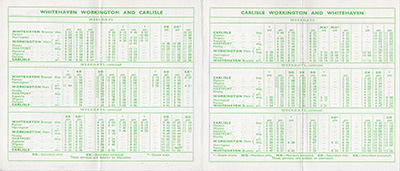
In 1963 summer Silloth services were worked by steam stock at weekends, on Monday - Fridays timings all the services to be operated by one Derby Lightweight set, the first in several summers not to be steam.22
1964
After three relatively quiet years big changes for the sets began in 1964. In July 79014 moved from Upperby to Workington, its first transfer.
Despite very succesful passenger figures after the introduction of the diesels, loadings were not sustained and the Silloth branch fell victim the Beeching axe, closing on 7 September 1964.
That month saw some shuffling of vehicles; 79011 from Upperby to Llandudno Junction, 79013 from Upperby to Newton Heath, and 79014/5 from Workington to Newton Heath.
1965
In January 79011 returned from Llandudno Junction to Upperby; in February there were many moves, 79010 returned to Upperby from Reddish, 79013/4/5 from Newton Heath to Upperby, the sets at Workington (79016/7/8/9/20) move to Upperby, and new arrivals into the area were 79121/122/123/124/125/126/127 transferred from Reddish to Upperby.

Upperby was now allocated 23 sets (the 13 originals and 79118-127).
The larger number of sets allowed other routes to be operated, including service to Barrow; the image shows one of the original Cumberland set arriving at Ravenglass in 1965. Roy Lambeth.
On May 21st the set working the 07:22 Lancaster - Barrow service was in a collision with the 07:32 Morecambe - Lancaster local service (traction unknown) in Lancaster Castle station.28 The cab of the DMBS was severerly damaged, the vehicle is thought to be M79120 which would be the first vehicle from the area to be withdrawn, on October 9th.
From 28th December the 06:30 Hawick to Carlisle and 18:13SX return were operated by a 2-car set.5
By the end of the year they were also operating the daily 9.00am Carlisle - Glasgow Central via Dalry, returning at 11:55.6
1966
On April 18th, 1966, the line from Workington to Keswick closed (the section from Keswick to Penrith remained open a few years longer). The Cumbria Railways website has a nice gallery of the line in its final days.

On the 31st May a derailment at Lugton saw the cancellation of the 11:55 Glasgow Central - Carlisle service preventing the return of the Derby Lightweight set, it was noted working the 22:45 Glasgow - Lanark service.7
The image show two sets at Kilmarnock on a Carlisle - Glasgow Central working, circa 1966. Stuart Rankin.
In June 79127 went on loan from Upperby to Reddish, leaving Upperby with 21 sets at the end of the year.
1967
Allocation changes:
January: 79128 Reddish to Upperby
4w/e 04/02/67 79130/144/145/148/177/179/180/181 Reddish to Upperby
4w/e 04/03/67 79146/171 Reddish to Upperby
5w/e 08/04/67 79127 ex-loan Reddish to Upperby
5w/e 08/04/67 79129/142 Reddish to Upperby
5w/e 08/04/67 79130/179 Withdrawn from Upperby
April: 79020 Withdrawn from Upperby (first original Cumberland set to be withdrawn).
15/07/67 79122 Withdrawn from Upperby
5w/e 12/08/67 79175 Longsight to Upperby
The changes equate to 15 arrivals and 4 withdrawals, a net increase of 11 meaning a total of 32 power cars at the end of the year (79008-19, 79118/9, 79121/3-9, 79142/4-6/8, 79171/5/7, 79180/1).
At the start of the year the 09:10 Sunday Hawick - Edinburgh was diagramed for a 2-car set from the Carlisle - Workington service, probably the set that worked the Saturday 18:13 Carlisle - Hawick. Noted operating this on February 5th were 79018 + 79608, on April 19th it was the turn of 79144 + 79675.8
On May 10th the DMU on the 06:41 Hawick - Carlisle failed and was rescued by Hawick pilot D8615.9
Observations in mid-September were 79015 (in green) with 79609 (in blue) on a service though Kilmarnock, and a visit to Upperby found 79128/45/77, 79675 in blue, while condemned vehicles 79120/30/79 were still in green.10
1968
Allocation changes:
w/e 06/01/68 79134/135/184/186/187 Bletchley to Upperby
3/2/68 79008/15/146/181 Withdrawn from Upperby
Monday 6th May 79009-14/6/7/8/9/134/148/187 Withdrawn from Upperby2
30/11/68 79124 Withdrawn from Upperby
The changes equate to 5 arrivals and 18 withdrawals, a net decrease of 13 meaning a total of 19 power cars at the end of the year (79118/9, 79121/3/5-9, 79135, 79142/4/5, 79171/5/7, 79180/4/6). There was also 20 trailers 79633/4/5/9, 79640-6, 79654/7, 79667/8, 79672/3/5/6/8. The May withdrawals marked the end of the original Cumberland sets.

The image shows one of the original Cumberland sets passing a lot of impressive signaling at Preston, Spring 1968. David Faircloth.
In 1968 the British Railways Board commissioned an Ultrasonic Test Train to be built, and it was decided that withdrawn Derby Lightweight vehicles would be suitable for conversion. Vehicles 79185 (withdrawn from Bletchley in January 1968) and 79612 were selected (withdrawn from Upperby in April 1967) and sent to the research centre at Derby. Once there there was the realisation that 79185 was fitted with an automatic gearbox and would not be suitable for the new task, so an alternative would be sought.3
From the May withdrawals 79018 was selected as the power car in the best condition and dispatched to Derby, arriving on Wednesday, 8th May.2
Noted lying condemmed in Upperby in April were 79015, 79122/30/79/81, 79602/47/80/3/4; with 79020 being cut up.11
After the sixteen sets were withdrawn in May the condemned sets at Upperby increased; they were noted on the 11th as being 79009/10/13-7/9/20, 79122/30/47/8/79/81/7, 79600-7/9/11/53/79/80/3/4; with 79130 being broken up and only the bogies and frames remaining from 79020.12
On a visit to Upperby on 6th September these condemned vehicles were noted: 79014-6/9, 79181, 79600/2/3/9/11/47/80/3.13

A month later, on October 5th, the following were noted still in service at Upperby: 79119/23/5/6/42/77/80/6, 79639/40/1/3/6/54/67/72. All but 79667 were in blue. Marked condemned: 79009/10/1/3/4/6/7/9, of which only 79013/9 and 79603/4/9 were in blue.14
Trailer 79633 was noted ex-works in blue on October 4th. The condemned vehicles noted on November 23rd were: 79009/10/1/3-7/9, 79124-43-67, 79600-9/47/53/79.15
The image shows a later 79xxx set at Birkby Drifts Pit, Cumbria on 27/07/1968, with a service heading for Whitehaven. The full yellow ends enhances the differences in windscreens with the horizontal bar standing out more than it did in green. Graeme Phillips Collection.
1969 - the last year in traffic
The year started with the closure of the Waverley route on January 4th.
The first casualty of the year was 79118, withdrawn from Upperby on February 22nd.
In March the remaining vehicles were transferred from Upperby to Kingmoor depot. This was probably just a paper move. The same month their replacements - Blue Square Derby Lightweights 50950-64 with trailers 56233-47 - arrived at Kingmoor (and apparently Barrow although all were officially allocated to Carlisle) from Manchester.
That allowed the final Carlisle Yellow Diamond sets to be withdrawn on the 19th April.
Their last day in traffic was the 12th April, noted in action that day were 79121/3/6/8/45/71/86 with 79639-42/73/8 and 55997. In the yards were noted 79009/10/1/3 - 7/9, 79118/9/21/4/5/35/42/4/75/87, 79600-9/11/33, 79643-7/53/4/7/68/75/6/8/9/80/3.16
On May 3rd Upperby was still full of Yellow Diamond vehicles, although 79141 with 79642 and 79144 with 79645 appeared to have recently been in use.17
It wasn't the only time vehicles were noted in use after withdrawal: on July 3rd BR held a 'Rail Day exhibition' in Carlisle station; this included a Yellow Diamond set running hourly trips to Kingmoor yard.18
Other sources indicate that the vehicles were kept in store and were not fully withdrawn in April. A BR memo dated June 26th notes "the only DMU vehicles likely to become surplus during the next 6 months are about 20 Yellow Diamond 2-car sets on hand at Carlisle and Norwich" suggests they were not done with them yet.19
The memo was relating to an enquiry by the Border Union Railway Railway Company (BUR) about purchasing DMU vehicles for its scheme to re-open the Waverley route between Carlisle and Edinburgh. By October the vehicles were available, the supplies department were retaining 16 condemned vehicles at Carlisle for possibly purchase. No price had been agreed, but their approximate value was noted as £1,000 each.20
1970
The Border Union Railway Company were given till 1st February 1970 to purchase the 16 vehicles, which they failed to do (the whole scheme ultimately failed through lack of funds), and on the 2nd February they were released for disposal.21. The sixteen vehicles kept for them were power cars 79119/121/123/127/129/145/180/184 and trailers 79633/5/40/57/68/72/73/78.
79635 was noted with others at Kingmoor on 7/3/7024, some had moved to Kettering by 21st June when 79184 79635/68/73 were noted there.25 More moved on July 9th when 79121/3/7/80, 79672/8 were noted heading through Chesterfield.26 Noted still intact at Cohens on 11/10/70 were 79119/121/123/127/129/145/180, 79633/40/72/78.27
Disposal
What happened to the vehicles after withdrawal can be split into two distinct sections - those withdrawn prior to their replacement (up to and including 79118 in February 1969) and the final mass withdrawal on 19/4/69.

Carlisle Upperby circa 1968/9. One vehicle is seen heavily dismembered, and others await their turn. DLPG Collection.
Pre-replacement
The power cars, other than special cases 79008/120/146, were either sold to Arnott Young (being moved to Troon or Fighting Cocks for cutting), or cut up on site at Upperby. Three different firms would cut up vehicles at Upperby:
JR Miller (four power cars April - July 1968);
J McWilliam (two power cars in January 1969);
and finally TW Ward (six power cars from July - August 1969).
Some trailers went to Arnott Young at Old Kilpatrick: 79600/79601/79602/79603 moving Carlisle to Old Kilpatrick as two specials on 13 June 1969.
Final Withdrawals
For the remaining vehicles which were held at Carlisle until October 1969, the sixteen vehicles which were held for the BUR would end up at G Cohen (Kettering), the others were disposed of immediately to Arnott Young (ten power cars to Dalmuir, the trailer cars to Old Kilpatrick).
Noted at Kingmoor on October 5th were 79125/6/35/77/86, 79639/42/5/6/54/67/5/6 "amongst others"23. These were all Arnott Young vehicles, so it could be assumed the "others" included the other Arnott Young power cars 79128/142/4/171/5.
The movement dates to Dalmuir / Old Kilpartick were:
6/10/1969 79125/79135/79142/79175 Carlisle to Dalmuir
7/10/1969 79126/79144/79171/79186 Carlisle to Dalmuir
8/10/1969 79128/79177 Carlisle to Dalmuir
8/10/1969 79646/79676 Carlisle to Old Kilpatrick
9/10/1969 79639/79642/79645/79667 Carlisle to Old Kilpatrick
13/10/1969 79654/79675 Carlisle to Old Kilpatrick
The Others
These are the LMR Derby Lightweight power cars that were never allocated to Carlisle:
79131/2/3/6, 79141/3/7/9, 79169/70/2/3/4/6/8, 79900/1.
Just 17 vehicles out of 66 total!
Sources
1LMR Memo: Motive Power Superintendent to C. Lakin, General Manager's Office October 7, 1955
National Archives - AN172-182 Diesel Lightweight Train General
2LMR Memo: General Manager to Chief Operating Officer, May 9, 1968
3Minutes of meeting at Derby, April 16, 1968
National Archives - AN129-181 Ultrasonic rail flaw testing coach
4LMR CM&EE Dept: Report RC2, Tests on Diesel Railcar Trains: West Cumberland Area November 1954
National Archives - AN95/5 Tests on Diesel Railcar trains: West Cumberland area
5Railway Observer, February 1966, p66
6Railway Observer, February 1966, p54
7Railway Observer, July 1966, p232
8Railway Observer, April 1967, p124
9Railway Observer, July 1967, p245
10Railway Observer, November 1967, p380
11Railway Observer, June 1968, p223
12Railway Observer, July 1968, p264
13Railway Observer, November 1968, p393
14Railway Observer, December 1968, p442
15Railway Observer, January 1969, p28
16Railway Observer, June 1969, p207
17Railway Observer, August 1969, p283
18Railway Observer, September 1969, p306
22Railway Observer, August 1963, p242
23Railway Observer, January 1970, p26
24Railway Observer, May 1970, p175
25Railway Observer, August 1970, p263
26Railway Observer, September 1970, p312
27Railway Observer, December 1970, p420
Railway Correspondence and Travel Society
19Memo: Chief Operating Officer to Chief Engineer (T&RS), June 26th, 1969
20Minutes of Meeting at BRB Headquarters, October 7th, 1969
21BRB Memo: Supplies Manager to Chief Secretary, February 2nd, 1970
National Archives - AN106/39 Border Union Railway Co (Edinburgh and Carlisle Line)
28Railway Magazine, August 1965, p468
Summary
Description
- Single cars
- Four-car sets
Drivers Instructions
Numbering
Liveries
Operations
- West Cumberland
- Lincolnshire
- East Anglia
- North Eastern Region
- North Wales
- Buckingham - Banbury
- Manchester
Non-Passenger Use
- Special Saloon
- Ultrasonic Test Train
Images
Details about preserved Derby Lightweights can be found here.



